Essential Guide to Pull Out Drawer Protectors
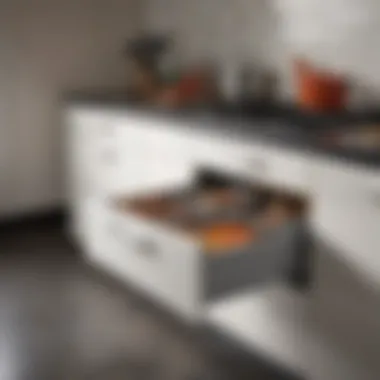
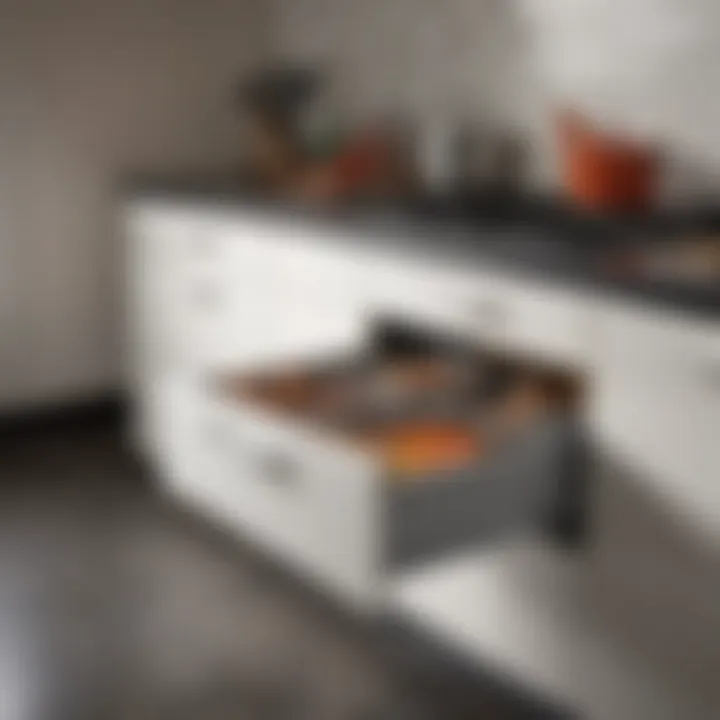
Intro
Pull out drawer protectors serve a crucial role in maintaining the usability and aesthetics of our drawers. They provide a barrier against scratches, stains, and wear, ensuring that drawers remain functional for years. Choose the right protector for your needs can make a substantial difference in drawer longevity and overall organization.
Understanding the options available in the market is essential. This guide will outline the various materials, installation techniques, and maintenance suggestions for pull out drawer protectors. A comprehensive grasp of these elements empowers homeowners to enhance their living spaces significantly.
Overview of Pull Out Drawer Protectors
Pull out drawer protectors are designed to cover the bottom surface of drawers, safeguarding against daily wear and tear. They are often made from durable materials such as rubber, silicone, or felt, depending on the desired level of protection and functionality. By utilizing these protectors, homeowners can preserve the integrity of their drawers, while also simplifying the cleaning process.
Benefits of Using Drawer Protectors
The use of pull out drawer protectors offers numerous advantages:
- Protection: They shield the drawer base from scratches and spills.
- Easy to Clean: Most materials are wipeable or washable, making maintenance simple.
- Noise Reduction: Certain protectors can help reduce noise when closing the drawer.
- Organization: They can improve the stability of items stored inside by providing a non-slip surface.
"Utilizing pull out drawer protectors is not just about protection; it's a strategic decision that enhances drawer functionality."
Materials and Styles
Understanding the different materials and styles available for pull out drawer protectors can help in making an informed choice. Here are the most common ones:
Common Materials
- Rubber: Known for its durability and grip, rubber protectors effectively prevent slipping.
- Silicone: Flexible and resilient, silicone is often used for its water-resistant properties.
- Felt: Soft and aesthetically pleasing, felt offers protection without adding too much bulk.
- Plastic: Lightweight and easy to cut, plastic protectors are an economical option.
Styles of Drawer Protectors
Drawer protectors come in various styles:
- Full Coverage: These cover the entire drawer base for maximum protection.
- Matte Finish: For a subtle, modern look that integrates well with many drawer designs.
- Decorative Designs: Some protectors feature patterns or colors that can enhance the drawer’s appearance.
Installation Tips
Installing pull out drawer protectors is a straightforward task. Here are some steps to guide you:
- Measure the drawer interior dimensions accurately.
- Cut the protector material to fit those dimensions if needed.
- Clean the surface of the drawer thoroughly to ensure proper adhesion.
- Place the protector inside the drawer, smoothing it out to eliminate air bubbles.
- Trim any excess material if necessary to achieve a neat finish.
By following these steps, you can install pull out drawer protectors effectively, ensuring they serve their intended purpose.
Maintenance of Drawer Protectors
To extend the life of your pull out drawer protectors, regular maintenance is necessary. Here are actionable tips:
- Wipe Down Regularly: Keep the surface clean by wiping with a damp cloth.
- Inspect for Wear**: Check your protectors every few months for signs of wear and replace them if necessary.
- Avoid Harsh Chemicals: When cleaning, steer clear of abrasive cleaning solutions that may damage the material.
By incorporating these maintenance practices, you can effectively preserve the functionality and appearance of your drawer protectors.
Foreword to Pull Out Drawer Protectors
Drawer protectors serve as crucial accessories for anyone seeking to maximize the durability and longevity of their storage spaces. This category of home improvement products is designed specifically to enhance the usability of drawers, whether these be in kitchens, offices, or bedrooms. Understanding the various dimensions of pull out drawer protectors is essential for homeowners, as their effective use can lead to better organization, easier maintenance, and extended shelf life for the drawers themselves.
Definition and Purpose
Pull out drawer protectors are materials that line the interior of drawers to safeguard their surfaces from scratches, spills, and general wear and tear. These protectors come in numerous styles and materials, depending on the specific needs of the user and the types of items stored in the drawers. The primary purposes include:
- Protection: They act as a barrier between the drawer surface and potential damaging items.
- Cleanliness: Protectors can be cleaned easily, significantly reducing the effort needed for drawer upkeep.
- Aesthetic Appeal: Many protectors also feature decorative designs, adding a touch of style to the drawer interiors.
In summary, the purpose of drawer protectors is not just functional but also integrates an element of personal expression in home storage solutions.
Market Demand and Popularity
The demand for pulling out drawer protectors has seen a notable rise in recent years. Factors contributing to this trend include:
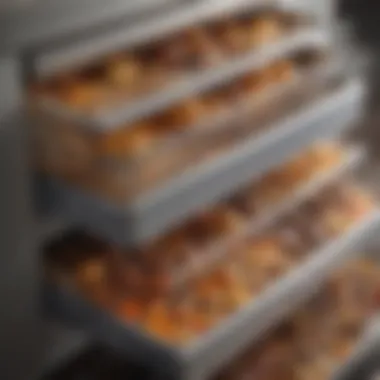
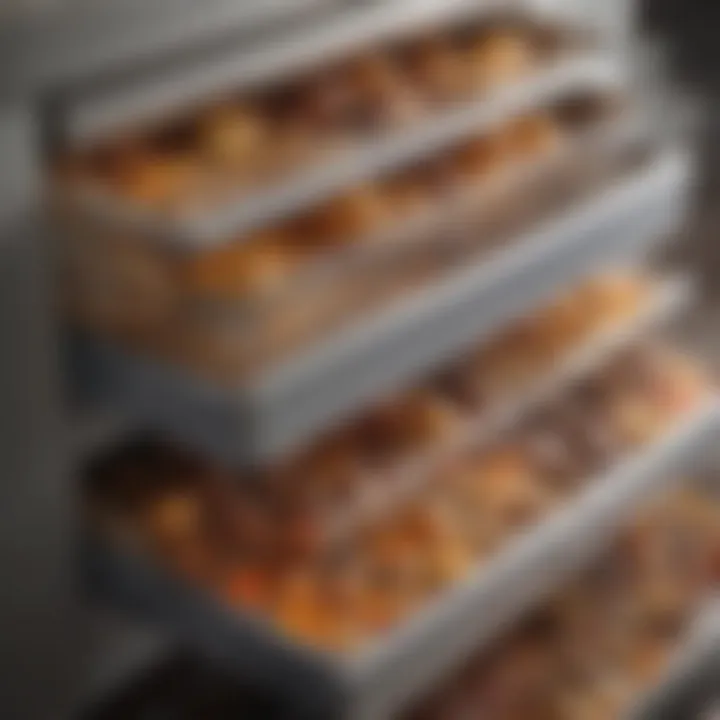
- Increased Awareness of Organization: More homeowners are prioritizing organization, leading to greater interest in products that can help maintain tidy spaces.
- DIY Home Improvement Culture: Social media platforms showcase innovative home design hacks, prompting greater interest in functional products like drawer protectors.
- Diverse Options: The market today offers a variety of options catering to different needs and tastes, making these protectors more appealing.
Ultimately, the popularity of pull out drawer protectors is rooted in their multifaceted benefits, making them an essential consideration for anyone invested in home and lifestyle improvement.
"By choosing the right drawer protector, one can uplift both the functionality and appeal of their storage solutions."
This guide aims to explore these aspects in more detail, equipping readers with the knowledge needed to make informed decisions.
Benefits of Pull Out Drawer Protectors
Pull out drawer protectors are essential for enhancing the lifespan and utility of drawers in any space. Their benefits extend beyond mere aesthetics. They serve a critical function by minimizing damage caused by everyday use. Understanding these benefits is key for those looking to maintain the appearance and functionality of their furniture.
Protection from Wear and Tear
One of the primary advantages of using pull out drawer protectors is their ability to protect against wear and tear. Drawers face constant friction from items being placed in and removed from them. With regular use, surfaces can scratch, scuff, or become discolored. By implementing protectors, you can create a barrier that absorbs impact and reduces scratches. This is particularly useful in kitchens where utensils and heavy pots might cause damage. Protectors also help prevent stains from spills, maintaining the drawer’s cleanliness and look.
Enhanced Organization
Pull out drawer protectors can greatly improve organization. The right protector provides a surface that keeps drawer contents from shifting. For example, in a kitchen drawer, a drawer liner can prevent knives, forks, and spoons from sliding around. This ensures that you can access items quickly when needed, saving valuable time during meal preparation. Furthermore, many protectors come with functionalities that allow for various compartments for better sorting. Enhanced organization leads to a more efficient workflow, whether you are cooking or searching for a tool in your workspace.
Ease of Cleaning
Cleaning drawers is often overlooked. However, using pull out drawer protectors simplifies this task significantly. Most protectors are designed for easy maintenance and many can be wiped down or rinsed off quickly. For instance, vinyl liners can just be removed and cleaned, leaving the drawer itself free from grime and dust. This not only maintains hygiene but also promotes a healthier environment at home. Consistent cleaning of drawers can also prolong their life and prevents build-up of unpleasant odors.
"A clean, organized drawer reflects a well-maintained home, making drawer protectors an underrated investment for any household."
Investing in pull out drawer protectors is a practical choice that brings several advantages. From safeguarding against damage to enhancing order, the benefits are clear. Understanding these aspects assists homeowners in making informed decisions about their storage solutions.
Types of Pull Out Drawer Protectors
Understanding the types of pull out drawer protectors is essential when it comes to enhancing the functionality and longevity of your drawers. Each type offers unique benefits, catering to different needs and preferences. Choosing the right protector not only preserves the integrity of the drawer's surface but also aids in easy maintenance and organization.
Adhesive Liners
Adhesive liners are designed for straightforward application. They adhere directly to the surface of the drawer, providing a secure fit. One significant advantage of using adhesive liners is their ease of installation. They usually come in rolls or sheets, cutting down preparation time. In addition, these liners offer a non-slip surface, which helps to prevent items from sliding around during use.
However, when selecting adhesive liners, consider the stickiness. Some can leave residue, which may damage the drawer surface upon removal.
Non-Adhesive Liners
Non-adhesive liners provide a versatile alternative. They can be easily repositioned without damaging the surface underneath. These types of protectors are often thicker than their adhesive counterparts. This thickness provides an extra layer of cushioning, which can be especially beneficial for storing fragile items.
Users may appreciate how non-adhesive liners can be washed and reused. They help in reducing waste and are often made from materials like rubber or fabric, which cater to varying aesthetic preferences.
Fabric Protectors
Fabric protectors add a touch of elegance to drawer interiors. They come in various designs and colors, allowing one to personalize the space. Beyond their aesthetic value, fabric protectors are soft, which offers a degree of cushioning for stored items. Additionally, these protectors are breathable, reducing the risks of moisture accumulation.
However, fabric protectors can attract dust and stains more than other materials, necessitating regular cleaning. They are ideal for drawers designated for delicate items or accessories.
Custom Cut Solutions
Custom cut solutions provide a tailored approach to drawer protection. These protectors can be made to fit specific drawer sizes and shapes. For individuals with unique or vintage drawers, this option ensures that every corner is covered adequately.
While they may involve a higher expense, the utility is attractive for those who are seeking precision. Moreover, custom solutions can often be made from high-quality materials, ensuring durability and longevity.
"Selecting the right type of drawer protector can transform your drawer organization, ensuring both functionality and style."
Materials Used in Drawer Protectors
Choosing the right material for pull out drawer protectors is crucial. The material not only affects the durability and functionality of the protectors but also influences ease of installation and maintenance. Each material offers unique benefits and considerations that can help consumers decide what is best suited for their drawers.
Vinyl
Vinyl is a popular choice for drawer protectors. This material is known for its durability and ability to withstand wear and tear. It is also water-resistant, which helps in preventing stains from spills. Vinyl protectors often come in various colors and designs, allowing for some element of personalization in drawers.
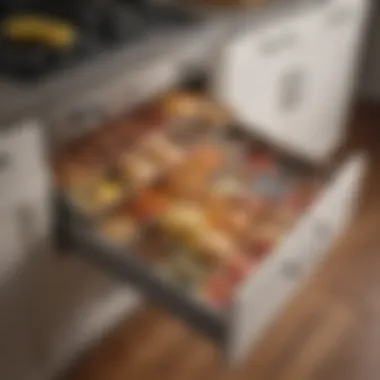
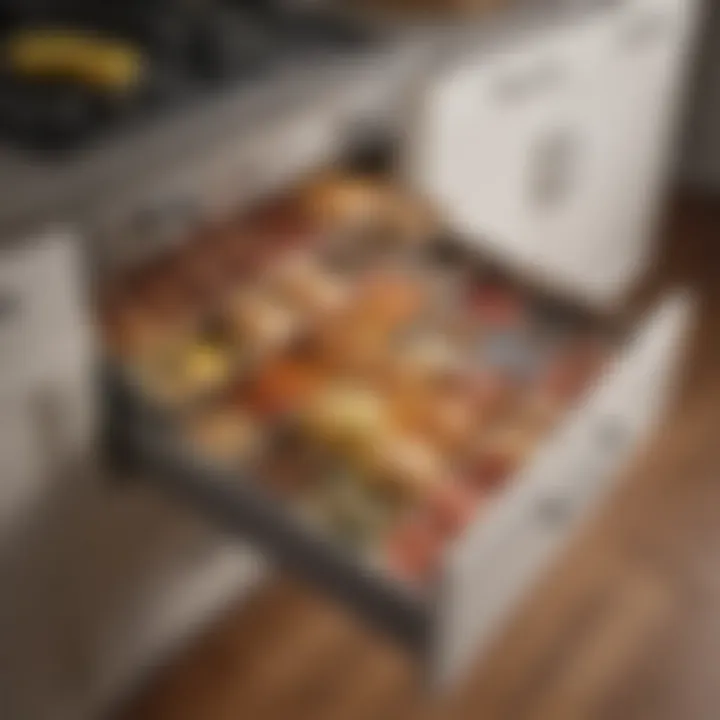
Additionally, vinyl is easy to clean. A simple wipe with a damp cloth is often enough to keep it looking fresh. However, over time, vinyl may lose its adhesive properties, especially if exposed to moisture frequently. Some people find that a weak adhesive can lead to shifting or curling at the edges.
Foam
Foam protectors are another viable option, particularly for more delicate items. The softness of foam provides cushioning, which can absorb impact and prevent scratches or dents. This can be especially important for drawers that hold fragile items, such as dishes or glassware.
Foam is lightweight and easy to cut to size, making installation straightforward. However, cleaning foam protectors typically requires more effort. They can trap dust and debris, so regular maintenance is needed to keep them in good condition. Despite this, their cushioning ability makes them attractive for specific applications, especially in kitchens or crafts.
Paper
Paper-based protectors are often the least expensive option. They are lightweight and come in a variety of patterns, making them visually appealing. Paper is suitable for basic protection against scratches and minor spills.
However, paper protectors have significant limitations. They are less durable than other materials and can wear out quickly under heavy use. Moisture can cause damage, making them unsuitable for drawers that might be exposed to liquids. Regular replacement is necessary, which can lead to added costs over time. Despite these drawbacks, they can be a suitable choice for temporary or low-stress applications.
Cork
Cork is an eco-friendly option that has gained attention recently. This natural material is resilient and offers comfort underfoot, making it an ideal choice for kitchen drawers. Cork naturally resists moisture, which helps in reducing odors and stains.
The texture of cork is also non-slip, reducing the chances of items sliding around within the drawer. Like foam, it's lightweight and can provide some cushioning for fragile items. However, while cork is durable, it may not be as easy to find in specific designs as other materials.
Choosing the Right Drawer Protector
Selecting the correct drawer protector is a key step in maintaining the integrity and functionality of your drawers. The right choice ensures they remain in good condition, providing protection from various elements such as dirt, moisture, and wear over time. With different options available, understanding the nuances of each type can lead to informed decisions that enhance the longevity and usability of your storage spaces.
Considerations for Drawer Material
One of the first elements to evaluate is the material of the drawer itself. Materials can range from wood, laminate, metal to plastic. For wooden drawers, consider liners that absorb moisture, as wood can warp or crack due to humidity. Laminate surfaces often benefit from non-adhesive liners that avoid any potential damage during removal. Metal drawers might require liners that offer cushioning to prevent scratches and dents. It is crucial to align the protector’s properties with the specific challenges posed by the drawer’s material.
Assessing Drawer Size
Another important aspect is the size of the drawer. Accurate measuring is essential. Measure the depth, width, and height of your drawers to ensure a snug fit for the protector. Poorly fitted protectors can slip or bunch, reducing their effectiveness. Additionally, oversized protectors can impede drawer functionality. Always choose protectors designed for easy customization, allowing adjustments without compromising the protective features.
Functionality Needs
Lastly, consider the functionality of the drawer. Will it hold delicate items, heavy tools, or frequent-use utensils? For drawers with fragile contents, opt for protectors that provide a non-slip surface and cushioning. For utility drawers, durability and ease of cleaning should take precedence. Knowing what items will be stored will dictate the level of protection and type of material needed.
"Choosing the right drawer protector is not just about aesthetics. It's about the long-term maintenance of your storage solution."
Installation Methods
Installation methods for pull out drawer protectors play a crucial role in maximizing their effectiveness. Proper installation ensures that the protectors function as intended, providing optimal protection and enhancing the organization of the drawers. Understanding the various installation methods allows users to select the right approach suited to their specific needs.
Preparation Steps
Before beginning the installation, certain preparation steps should be taken to ensure a smooth process. First, gather necessary tools such as scissors, a measuring tape, and possibly an adhesive if chosen protectors require it. The drawer's interior surfaces should be cleaned thoroughly to remove dust and grease. This helps the protectors adhere properly. Additionally, measure the dimensions of your drawers accurately to ensure that the protectors fit correctly without any excess material.
Step-by-Step Installation
The installation process can vary based on the type of protectors being used. For adhesive liners, follow these steps:
- Cut the liner to the correct size, ensuring to leave a bit of margin for adjustments.
- Peel off the backing of the adhesive liner.
- Align the liner within the drawer, starting from one end and slowly laying it down to avoid air bubbles.
- Smoothen the liner using a soft cloth or your hand, ensuring it adheres well to the surface.
For non-adhesive liners, the steps are different:
- Measure and cut the liner to fit the drawer's dimensions.
- Place the liner in the drawer, ensuring it lays flat.
- Adjust if necessary for a snug fit.
Fabric protectors may require different handling. Often, they come with elastic bands or straps to keep them in place. Ensure to read any specific instructions provided by the manufacturer for best results.
Common Mistakes to Avoid
When installing drawer protectors, certain mistakes can hinder their effectiveness. One common error is not cleaning the drawer sufficiently before application. This can lead to poor adhesion and cause the liner to peel over time.
Another mistake includes miscalculation of size. If the protector is cut too small or too large, it won't serve its purpose well. Additionally, failing to smooth out air bubbles can lead to areas of the liner not adhering properly, which can result in wear and tear on the drawer itself.
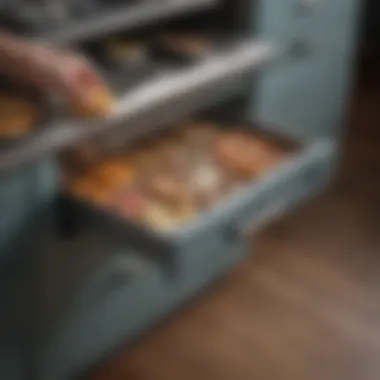
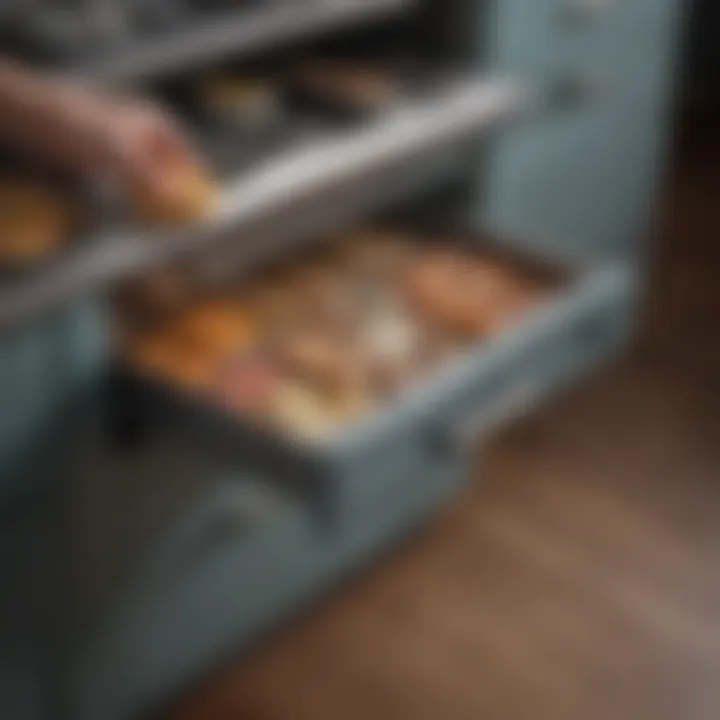
In summary, taking time to prepare and install the drawer protectors correctly can significantly enhance their functionality and longevity.
Maintenance of Drawer Protectors
Maintaining drawer protectors is crucial for ensuring their effectiveness and prolonging the life of both the protectors and the drawers themselves. Regular maintenance not only helps to prevent wear and tear but also keeps the drawers organized and sanitary. Taking time to care for these protectors can lead to a more pleasant experience when accessing items stored within the drawers. The benefits of maintenance include enhancing the aesthetics of the storage space, preventing damage to the drawer surfaces, and ensuring that the protectors continue to function as intended.
Regular Cleaning Techniques
To maintain pull out drawer protectors, regular cleaning is essential. Depending on the material of the protectors, different techniques may apply:
- Vinyl Protectors: Use warm, soapy water and a soft cloth to wipe down vinyl protectors. Avoid abrasive cleaners that can scratch the surface.
- Foam Protectors: These should be lightly vacuumed. If they get stained, a damp cloth with a mild detergent will suffice.
- Paper Protectors: Simple dusting may work, but for deep stains, consider replacing them entirely.
- Cork Protectors: They can be wiped gently with a slightly damp cloth. Don’t soak them to prevent mold growth.
Applying these cleaning techniques regularly can help maintain the integrity of drawer protectors and the surfaces beneath them.
Signs of Wear
It is essential to recognize the signs of wear on drawer protectors. Early detection allows for timely maintenance or replacement, which can prevent more extensive damage. Look for the following indicators:
- Discoloration: An uneven color or fading can suggest that the protector is degrading.
- Tears or Rips: Physical damage can compromise the protective layer.
- Odor: A foul smell may indicate mold or mildew growth, particularly in damp environments.
- Peeling or Bubbling: Specifically in adhesive liners, peeling can create an ineffective barrier.
Being attentive to these signs can help decide when it’s time for replacement, thereby preserving the condition of your drawers.
Replacement Guidelines
When it becomes clear that drawer protectors are no longer effective, replacement becomes inevitable. It’s important to follow straightforward guidelines when replacing protectors:
- Timing: Replace protectors at least once a year or sooner if you notice significant wear.
- Selection: Choose replacements based on the same requirements as the original—considering size, material, and function to match the drawer's needs.
- Installation: Follow proper procedures for the new protectors to ensure they adhere correctly and do not shift over time.
- Disposal: Dispose of old protectors responsibly, considering recycling options if available—especially for materials like cork or foam.
By adhering to these guidelines, homeowners can maintain the functionality of their drawers, ensuring a tidy and efficient storage solution.
"Regular maintenance of drawer protectors enhances not just their longevity but also the usability of the drawers they shield."
This mindfulness in maintaining drawer protectors is a practical approach that leads to a well-organized and efficient living space.
Drawer Protector Trends
As the demand for organization and preservation in home environments increases, the concept of drawer protectors has evolved. Homeowners are not only looking for functionality but also for styles that fit into their design ethos. This has led to innovation in materials, eco-friendly options, and overall aesthetic appeal of drawer protectors. Understanding these trends is crucial for making informed choices that reflect both practicality and style in drawer maintenance.
Eco-Friendly Options
Sustainability is becoming more prominent across all sectors, including home improvement. As a result, many manufacturers of drawer protectors are producing eco-friendly options. These products are often made from natural materials such as recycled paper, cork, or organic cotton. By choosing these alternatives, consumers not only reduce their environmental impact but also improve indoor air quality by avoiding harsh chemicals often found in synthetic materials.
Using eco-friendly drawer protectors can be a healthier choice for households, especially where children or pets are present. Beyond safety, these options often come in various patterns and colors, allowing for customization without sacrificing ecological integrity. Consideration for sustainable choices in drawer protection goes beyond mere functionality; it also resonates with a growing awareness of our environment and health.
"Eco-friendly materials are designed to protect your drawers just as effectively without the added burden on the planet."
Choosing eco-friendly options does not mean one has to compromise on utility or durability. They can be just as effective in protecting against spills and scratches as conventional protectors, and they often feature user-friendly installation methods.
Innovative Designs
The aesthetic appeal of drawer protectors is another trend that cannot be overlooked. Innovative designs focus on enhancing not just the usability but also the overall visual appeal of drawers. Manufacturers are exploring new patterns, colors, and textures to create products that complement home interiors.
For instance, there are protectors with adhesive backing that can transform a plain drawer into a standout feature with minimal effort. Some designs even mimic high-end textiles, adding a touch of luxury while still fulfilling their protective role. This merging of design with practicality means homeowners are more likely to adopt the use of drawer protectors, as they become a natural extension of their decor rather than just a necessary protection measure.
When shopping, look for drawer protectors that have embossed patterns or vibrant colors, as these can enhance your storage spaces and make them more engaging. Innovative options also include removable and washable fabric or vinyl protectors, which ensure easy maintenance while offering style.
In summary, the trends related to drawer protectors reflect a broader shift towards holistic home organization. Eco-friendly options and innovative designs are essential for achieving both functionality and style, illustrating that practical solutions can align with contemporary aesthetic preferences.
Epilogue
Summarizing the Importance
Pull out drawer protectors serve a critical role in maintaining the integrity and functionality of drawers in many settings, be it kitchen, office, or garage. The significance of these protectors is often overlooked, yet they contribute to prolonging the lifespan of drawers. They prevent scratches and stains, ensuring that the drawer surfaces remain visually appealing while also making them easier to clean. By integrating drawer protectors into household management routines, occupants can significantly reduce the wear that comes from everyday use.
Moreover, drawer protectors foster an organized space, making locating items simpler. This aspect not only enhances usability but also minimizes the time spent searching for objects. With the right choice of material and proper installation, these products essentially act as a shield against both physical and cosmetic damage, promoting a more efficient environment.
Encouraging Practical Choices
When it comes to selecting pull out drawer protectors, making informed decisions is paramount. Homeowners should assess the various materials available, considering factors like durability, ease of maintenance, and eco-friendliness. Protectors made from natural materials such as cork offer a combination of sustainability and functionality, while vinyl options may provide easier cleaning yet consume more synthetic resources.
Furthermore, it is essential to understand drawer dimensions and the specific needs based on usage frequency. For high-traffic areas, a more resilient option may be required compared to light-use spaces.







